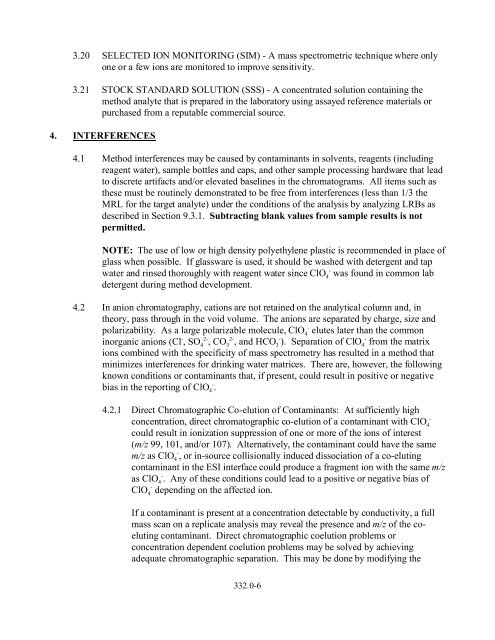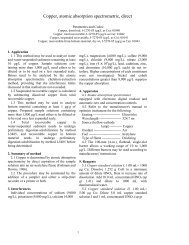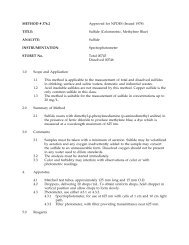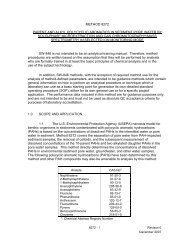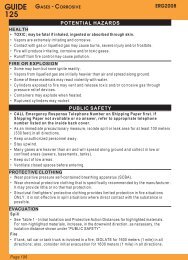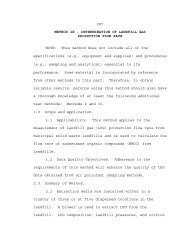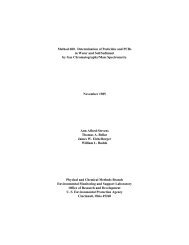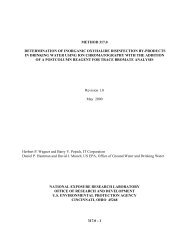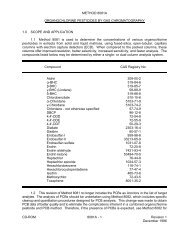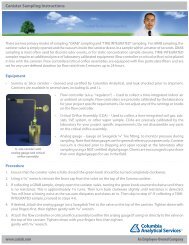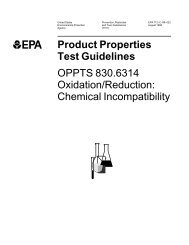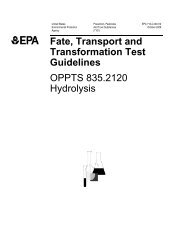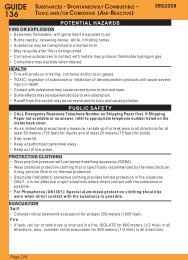View Actual EPA Method 332 (PDF File) - Columbia Analytical ...
View Actual EPA Method 332 (PDF File) - Columbia Analytical ...
View Actual EPA Method 332 (PDF File) - Columbia Analytical ...
Create successful ePaper yourself
Turn your PDF publications into a flip-book with our unique Google optimized e-Paper software.
3.20 SELECTED ION MONITORING (SIM) - A mass spectrometric technique where only<br />
one or a few ions are monitored to improve sensitivity.<br />
3.21 STOCK STANDARD SOLUTION (SSS) - A concentrated solution containing the<br />
method analyte that is prepared in the laboratory using assayed reference materials or<br />
purchased from a reputable commercial source.<br />
4. INTERFERENCES<br />
4.1 <strong>Method</strong> interferences may be caused by contaminants in solvents, reagents (including<br />
reagent water), sample bottles and caps, and other sample processing hardware that lead<br />
to discrete artifacts and/or elevated baselines in the chromatograms. All items such as<br />
these must be routinely demonstrated to be free from interferences (less than 1/3 the<br />
MRL for the target analyte) under the conditions of the analysis by analyzing LRBs as<br />
described in Section 9.3.1. Subtracting blank values from sample results is not<br />
permitted.<br />
NOTE: The use of low or high density polyethylene plastic is recommended in place of<br />
glass when possible. If glassware is used, it should be washed with detergent and tap<br />
water and rinsed thoroughly with reagent water since ClO 4- was found in common lab<br />
detergent during method development.<br />
4.2 In anion chromatography, cations are not retained on the analytical column and, in<br />
theory, pass through in the void volume. The anions are separated by charge, size and<br />
polarizability. As a large polarizable molecule, ClO 4- elutes later than the common<br />
inorganic anions (Cl - , SO 4<br />
2-<br />
, CO 3<br />
2-<br />
, and HCO 3- ). Separation of ClO 4<br />
-<br />
from the matrix<br />
ions combined with the specificity of mass spectrometry has resulted in a method that<br />
minimizes interferences for drinking water matrices. There are, however, the following<br />
known conditions or contaminants that, if present, could result in positive or negative<br />
bias in the reporting of ClO 4- .<br />
4.2.1 Direct Chromatographic Co-elution of Contaminants: At sufficiently high<br />
concentration, direct chromatographic co-elution of a contaminant with ClO 4<br />
-<br />
could result in ionization suppression of one or more of the ions of interest<br />
(m/z 99, 101, and/or 107). Alternatively, the contaminant could have the same<br />
m/z as ClO 4- , or in-source collisionally induced dissociation of a co-eluting<br />
contaminant in the ESI interface could produce a fragment ion with the same m/z<br />
as ClO 4- . Any of these conditions could lead to a positive or negative bias of<br />
ClO 4<br />
-<br />
depending on the affected ion.<br />
If a contaminant is present at a concentration detectable by conductivity, a full<br />
mass scan on a replicate analysis may reveal the presence and m/z of the coeluting<br />
contaminant. Direct chromatographic coelution problems or<br />
concentration dependent coelution problems may be solved by achieving<br />
adequate chromatographic separation. This may be done by modifying the<br />
<strong>332</strong>.0-6


